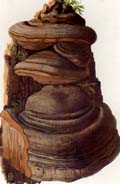 Key to Gilled Mushrooms Key
Key to Gilled Mushrooms KeyThis is a key to gilled mushrooms, that is, mushrooms having a definite cap with a fertile surface consisting of gills. The fruiting body usually also has a stem, although that may be lateral or absent (usually, then, the mushroom is growing from wood). You can use this key to identify mushrooms that you find.
 Polyporaceae Family
Polyporaceae FamilyFertile surface usually a layer of vertical tubes, of which the mouths are visible as pores on the underside of the cap or shelf.
Fruiting bodies usually tougher or harder than the "normal" gilled mushrooms, being leathery, corky, or woody. But they can be quite tender while actively growing
Once grown, they do not decay easily, remaining on the substrate for months or years
They often grow on wood, although a few are terrestrial (even those are usually growing on buried wood)
Fruiting body is usually a flat shelf, or hoof-shaped, protruding directly from the substrate, although sometimes it may have a short stalk.
Some forms never grow away from the substrate at all, so that all that is visible of the fruiting body are the pores.
Sometimes the pores are so minute that the fertile surface seems solid, until you look closely
 Lignicopolypore Subfamily
Lignicopolypore SubfamilyGrowing on wood
Sessiloporus TribeNot fitting the other choices, not stipitate
In making choices below based on texture and size, place the emphasis on texture: if left alone, some of the smaller ones can eventually get quite big; and even the huge ones have to start out small at first
Big Sessilopolypore Subtribe

Diagnosis
Narrow down your identification:
 Fomes Genus
Fomes Genus
Fomitopsis Genus- Pore surface and context white to tan or pinkish
-
Causes a brown cubical rot, mainly on conifers
Heterobasidion Genus
 Phellinus Genus
Phellinus Genus- Context dark reddish brown or yellowish brown, staining black with KOH
-
Causing a white rot in living wood
 Piptoporus Genus
Piptoporus Genus- White (sometimes tan to greyish brown), suede-like cuticle that forms inrolled, curb-like sterile margin
-
On dead or living birch trees






 Key to Gilled Mushrooms Key
Key to Gilled Mushrooms Key Polyporaceae Family
Polyporaceae Family Fomes Genus
Fomes Genus Piptoporus Genus
Piptoporus Genus




